Capsule Review: EVGA GeForce GTX 780 Superclocked ACX
by Ryan Smith on September 22, 2013 12:00 PM ESTOverclocking
Having taken a look at stock performance, let’s dive into overclocking quickly. Since the 780SC ACX is based on the reference board design it has the same limits as the reference GTX 780 when it comes to overclocking. The max TDP is just 106%, and the max voltage is 1.2v. As a result overclocking headroom won’t be very different from the reference GTX 780, with the ACX cooler and EVGA’s superclocked binning being the only significant differences from a reference card.
| EVGA GeForce GTX 780SC ACX Overclocking | |||||
| Stock | Overclocked | Ref GTX 780 OC | |||
| Core Clock | 967MHz | 1042MHz | 1063MHz | ||
| Boost Clock | 1020MHz | 1095MHz | 1102MHz | ||
| Max Boost Clock | 1123MHz | 1215MHz | 1228MHz | ||
| Memory Clock | 6GHz | 6.8GHz | 7GHz | ||
| Max Voltage | 1.162v | 1.2v | 1.2v | ||
In the end even with binning in play the 780SC ACX isn’t capable of overclocking any higher than our reference GTX 780; in fact it’s a hair worse, with the 780SC ACX topping out at 19MHz less than the reference GTX 780. So from a clockspeed perspective this is a wash. Pushing any higher will require more TDP headroom and more voltage, which in turn will require a fully custom design.
At the same time given the fact that EVGA has already eaten into a lot of the GTX 780’s overclocking headroom with their factory overclock, this means there’s not as much overclocking headroom available for the end user. 967MHz to 1042MHz is still a free 8% increase in clockspeeds; the payoff just isn’t as great as relative to a stock GTX 780.
Moving on, as a result of their similar overclocks, overclocked performance is virtually indistinguishable from our overclocked GTX 780. Despite the ACX cooler keeping temperatures in the low 70s we’re primarily power constrained here, which isn’t something the ACX cooler can help with.
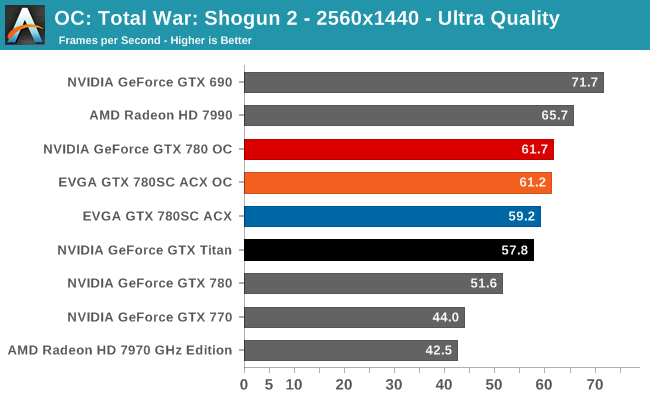
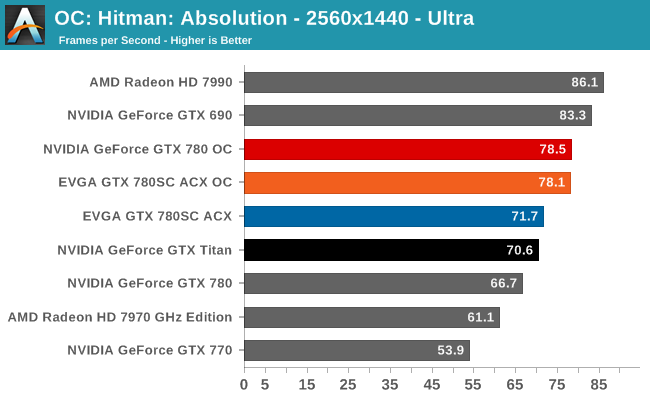
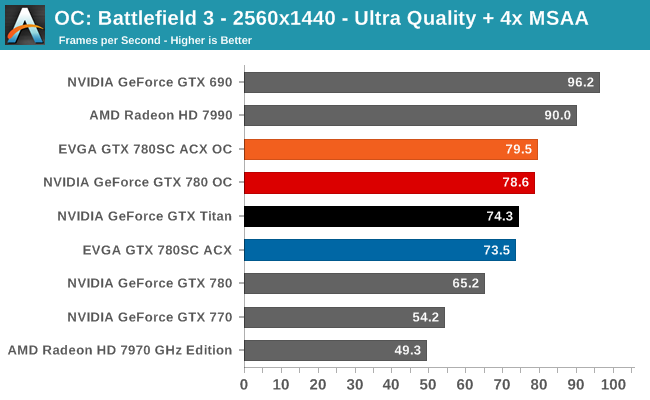
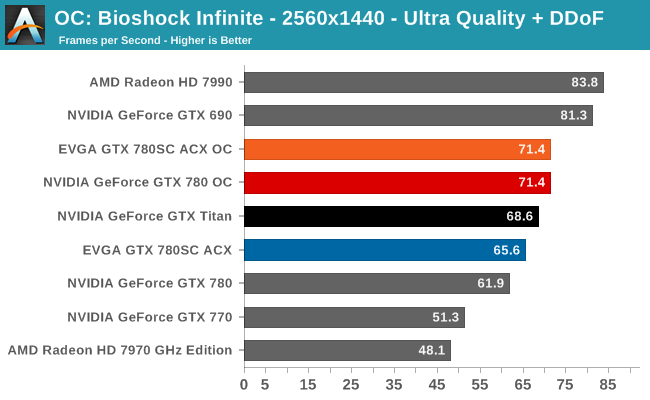
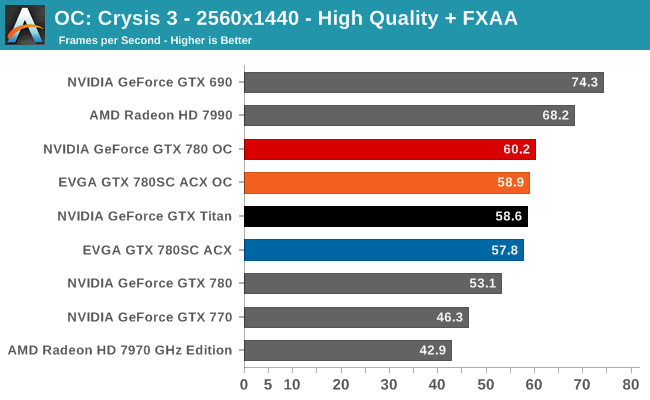
As was the case with overclocking the reference GTX 780, the payoff here is GPU performance that’s well ahead of the GTX 780 at stock, and performance that exceeds even GTX Titan by around 7%.
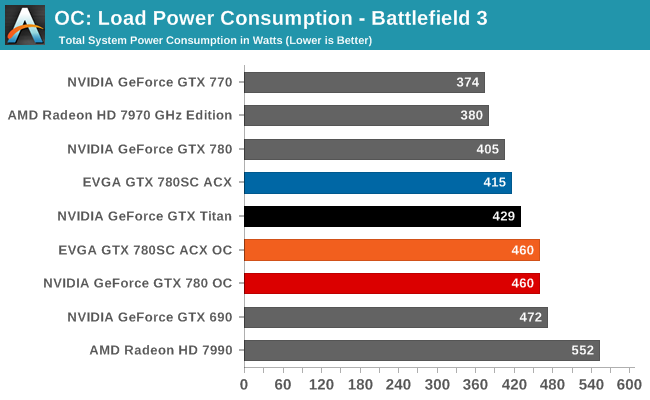
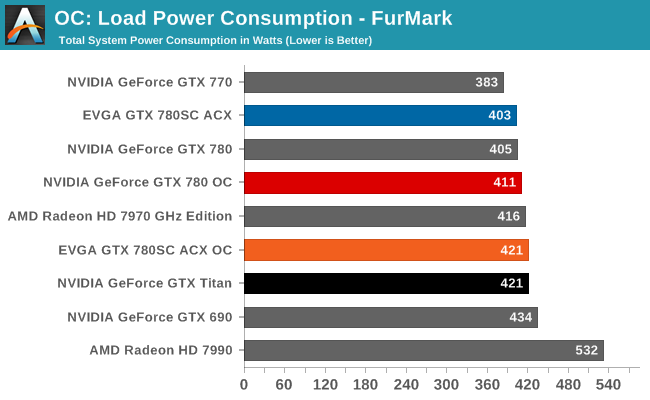
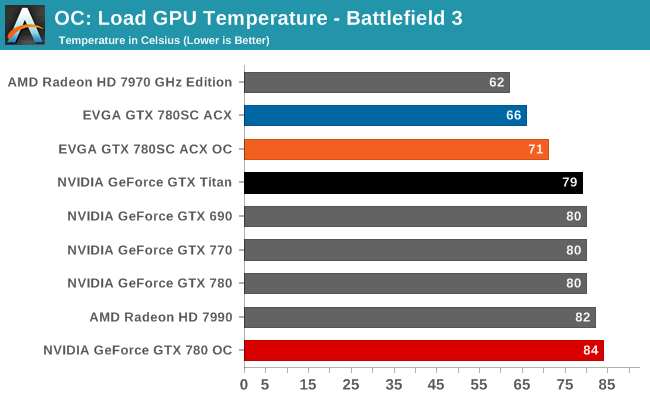

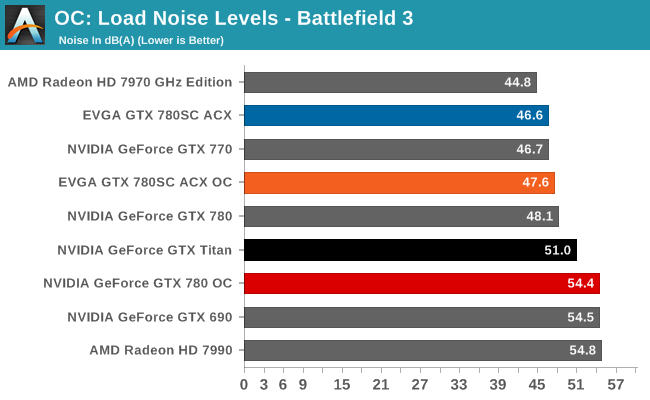
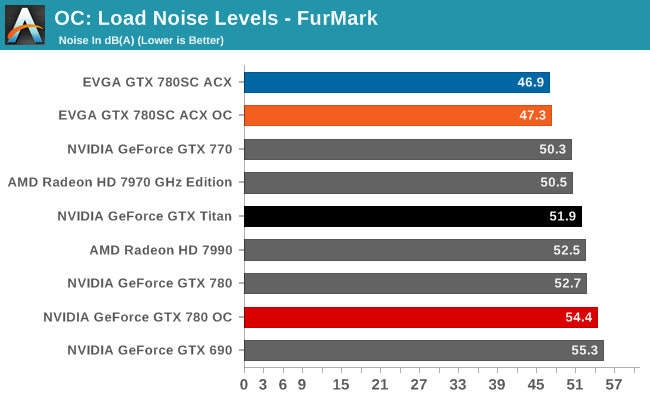
Finally, quickly taking a look at power, temp, and noise after overclocking we can see that the 780SC ACX maintains its strong cooling performance, with temperatures topping out in the low 70s and noise levels rising by just 1dB. The power cost of overclocking is fairly high however, thanks to the use of higher voltage boost bins.
All told, the 780SC ACX’s sweet spot is going to be at stock. While it’s as good an overclocker as any reference GTX 780, the fact that EVGA gives you so much of its overclockability out of the box with a trivial power cost means that the benefits of squeezing out the last bit of headroom don’t pay off quite as nicely here as with a stock card. The ACX cooler will have no problem keeping temperatures and noise levels down however, which means being able to reap the benefits of GTX 780 overclocking without the noise penalty.
Final Words
Wrapping things up, it’s clear that EVGA has put together an extremely solid card with their GeForce GTX 780 Superclocked ACX, both on the basis of performance and relative value. As we alluded to at the start of this article, EVGA is offering a sizable factory overclock for an absolutely tiny price premium, and as a result the 780SC ACX looks extremely good on a price/performance basis. For $10 more than a stock GTX 780 the 780SC ACX delivers 10% better performance, does so with just a trivial increase in power consumption, and ultimately closes the performance gap with GTX Titan. On this basis the 780SC ACX is a much better value proposition than your typical factory overclocked card, to the point where the stock card rarely makes sense. For all practical purposes the stock GTX 780 has been rendered redundant because of this.
Clockspeeds and prices aside, the other matter at hand is EVGA’s new ACX cooler. As yet another twin fan open air cooler the ACX cooler isn’t going to be groundbreaking, but that hasn’t stopped EVGA from taking the basic principles of the design and put together a very solid cooler. The build quality itself is quite good, and although this doesn’t match the metal madness that is the reference GTX 780, the ACX is as sturdy as any open air cooler can hope to be. Meanwhile in making the usual tradeoffs that come with the design, the ACX cooler offers notably better cooling than the GTX 780’s reference cooler, sustaining lower temperatures and less noise than its blower based counterpart. It goes without saying that for systems that can support this style cooler this is a very good tradeoff to make.
With that in mind, EVGA is off to a good start with their new cooler. If EVGA can sustain this level of quality and performance across their product tiers, then EVGA should have no trouble at all achieving their goals and broadening their reach into open air cooling.


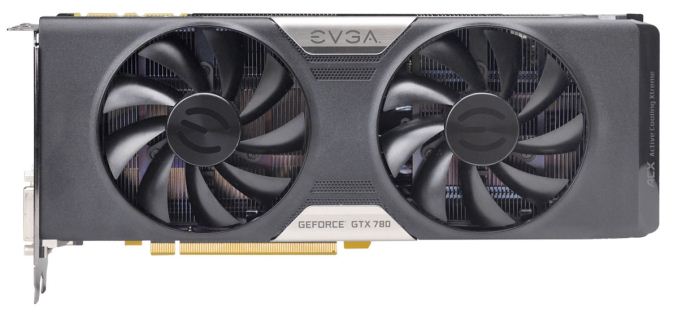








40 Comments
View All Comments
MrCommunistGen - Sunday, September 22, 2013 - link
Can you fix the Boost Clock value for the ACX in the table on the first page? It doesn't match the narrative and the current value in the table does not make logical sense.solien - Sunday, September 22, 2013 - link
hyyyymmrezaie - Sunday, September 22, 2013 - link
Silverstone "FT03-MINI" is very small. Does it make sense to use this card instead of the stock cooler that blows air out of the case? I really like the look of the case, and it seems the most exciting case for me right now.Samus - Sunday, September 22, 2013 - link
You'd want to use a blower-style cooler in either the FT03 or FT03-Mini. There isn't an exhaust fan to pull out all the heat an open-air cooler produced. I have trouble cooling my passive-cooled 7750 on my FT03-mini because of this.mmrezaie - Monday, September 23, 2013 - link
Thanks. I will settle for a normal GTX 780 for my FT03 mini.merikafyeah - Sunday, September 22, 2013 - link
At $660 only a fool would buy this instead of Galaxy's HOF edition GTX 780 which is $690.What Galaxy did with that card is nothing short of astounding and a complete departure from practically anything they've released thus far. The HOF card can easily reach 1300 MHz core clock and when pushed gets so close to a GTX 690 that only a bigger fool would choose a 690 over the HOF 780, which has none of the problems associated with multi-GPU cards and is $300 cheaper than a 690..
The GTX Titan cannot, I repeat CANNOT, beat the HOF 780's stock settings in ANY game benchmark, unlike this EVGA ACX card which lost against the Titan in more than one benchmark.
Seriously, Anandtech, if you ever get the chance to review this card, do it. There is no faster single GPU card for gaming on the planet, and I'm betting AMD's Hawaii flagship will have a tough battle ahead.
inighthawki - Sunday, September 22, 2013 - link
The ACX has enough headroom to also be pushed further than a GTX Titan, and the HOF is massive, making it incredibly difficult, if not impossible in most cases, to SLI them together.merikafyeah - Monday, September 23, 2013 - link
My point was the ACX has to be pushed to beat the Titan decisively. The HOF beats the Titan out-of-the-box, and when pushed, gives the Titan an even more thorough beating. Yes the cooler is large, but it does it's job really well as the temps never exceed 75C even when the card is pulling 501W from the wall. Still, the cooler can be replaced, what's more important is the PCB design which is simply put, a work of art. So much so that I am quite surprised it was made by Galaxy given their past record of being one of the lesser card manufacturers, so it makes sense that they would not have spared any expense at this point to make a name for themselves. There's a good reason why the LN2 GPU world records were made using the HOF GTX 780, and not say, the EVGA 780 Classified.Nfarce - Monday, September 23, 2013 - link
@merikayfyeah - I'll trust EVGA's superior support and warranty any day to a few more frames with a hyper-clocked Galaxy card, thanks.DPOverLord - Monday, October 7, 2013 - link
I would trust EVGA before anyone else, also it would be nice to see how this works against Titans in SLI on surround displays 1440p / 1600p surround. This is where the titan excels.